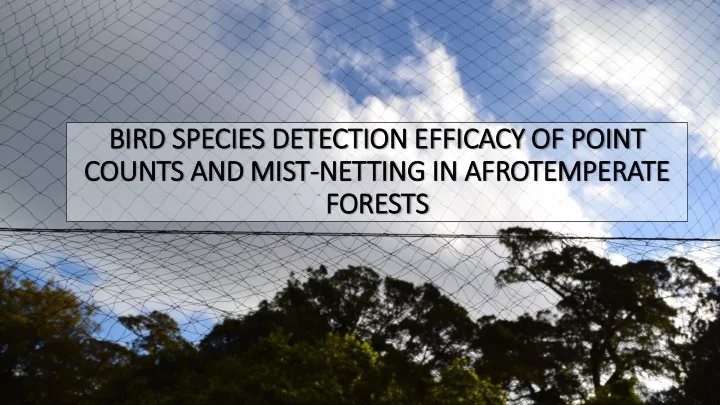

BIR IRD SPECIES DETECTION EFFIC ICACY OF POIN INT COUNTS AND MIS IST-NETTING IN IN AFROTEMPERATE FORESTS
Study Area • 6 Afrotemperate forests in the Eastern Cape • Per forest: • 10 point count stations • 1700 mist-net hours • How well can these methods detect bird species?
Checklist construction • QDGCs over each forest • SABAP2 + survey species lists • Assess for forest-utilization • Migrants included • Nocturnal birds + vagrants omitted • 187 forest-utilising species in EC • Functional trait categories from Martin et al . (2017) • Functional traits from local literature
Best-ranked model predicting species detection Number Odds Variable Level % of Total P of species ratio Intercept - - - 0.04 <0.001 Method Point 118 68.6 10.39 <0.001 Net 55 32.0 1.00 - Size Small 77 70.64 5.11 <0.001 Medium 22 88 4.49 0.004 Large 20 52.63 1.00 - Stratum Understorey 15 100 18.36 <0.001 Mid-storey 5 100 22.17 0.015 Canopy 48 96.00 13.63 <0.001 Edge 41 48.24 1.94 0.19 Bush Blackcap Lioptilus nigricapillus Aerial 10 58.82 1.00 - Specialisation Specialist 31 100 1.17 0.76 Generalist 28 87.50 - 1.00 Woodland 40 57.97 0.37 0.03 Open 20 50 0.51 0.19
Discussion • Martin et al . (2017) assessed survey methods in two global forest: • Point counts > mist-netting in both forests • Point counts better in higher canopied forests • Mist-netting comparatively better in the low- canopied forests with species-rich understorey • Species-poor understoreys in EC forests • Point counts are more reliable in EC forests • Biases need to be determined for different habitats + regions • Survey biases to be understood for accurate ecological inferences
Acknowledgements • Foundational Biodiversity Information Programme (FBIP) of the National Research Foundation (NRF) for project funding • Managers of DAFF state forests and ECPTA reserves for permission and assistance with fieldwork • Andrew Wannenburgh for assistance in creating the map of surveyed forests • Daan Nel for assistance with logistic regression modelling
Recommend
More recommend